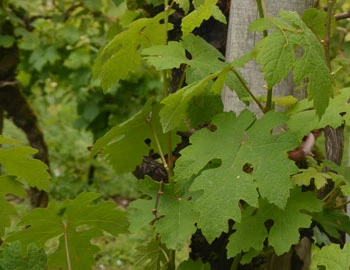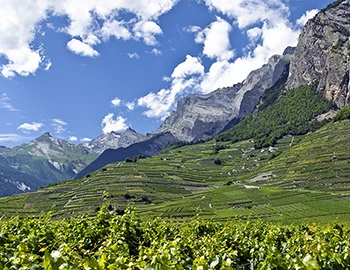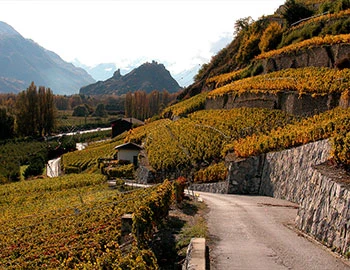
Clos de Mangold Humagne Blanche 2022
AOC Valais, Domaine Cornulus, 750 ml

| Grape variety: | Humagne blanc |
| Producer: | Domaine Cornulus |
| Origin: | Switzerland / Wallis |
| Other vintages: |
Description
This wine is made from the rare, oldest, indigenous Humagne Blanche grape variety, which is cultivated on the western slope of the vineyard. It has a fragrant, floral bouquet with notes of lime blossom, Williams pears and a hint of flintstone and chalk. On the palate, its varietal, juicy and lively freshness unfolds. It presents itself delicately floral with a fine covering haptic and immediately makes you want to take the next sip.
Attributes
| Origin: | Switzerland / Wallis |
| Grape variety: | Humagne blanc |
| Ripening potential: | 1 to 6 years |
| Drinking temperature: | 10 to 12 °C |
| Food Pairing: | Apéro riche, Whole baked fish, Fresh water fish with cream sauce, Mild Asian dishes, Salad with vegetables, pulses, pasta, Asparagus specialities |
| Harvest: | hand-picking with simultaneous grape sel |
| Maturation: | in amphoras, in cement egg |
| Volume: | 12.5 % |
| Note: | Contains sulphites |
Humagne blanc
The maternity wine
Every Valaisan midwife knows this grape. Humagne blanc reportedly has a high iron content; for this reason, their wines have long been known as “Wöchnerinnenweine” (maternity wine). By now we know that it was more likely the medicinal herbs, blended into the hot grape juice, which helped young mothers back on their feet. In any case: the white Humagne grape – unrelated to Humagne rouge – has been rooted in Valais for centuries. It was first mentioned in 1313. It is suspected to have immigrated from the south of France, but today it practically only grows in Switzerland. Its hallmark is a delicate scent of lime blossom and vineyard peach, a tightly-woven structure and the typical mineral impression that the wines leave on the tongue. Store these wines for a few years and they become the ideal companions for mature, strong cheeses.

Wallis
Valais: Alpine wines with class
More than 20 varieties of grapes can yield wines in Valais that are full of character. A large number of them grow on spectacular, steep slopes. Sealed off by mighty chains of mountains, old plantings like Petite Arvine, Amigne and Cornalin have survived in Valais, and today they are highly sought-after by wine enthusiasts. The highest vineyards in Europe are also found in Valais: the Savignin vines (known here as “Heida”), rooted in the mountain community of Visperterminen.

Switzerland
Switzerland – A small country with enormous diversity
Switzerland is famous for its banks, watches, and cheese, but not necessarily for its wine. The Swiss didn't invent wine, but they have been extremely open and curious to it. Wine culture arrived in what is now modern Switzerland via several routes: from Marseilles to Lake Geneva and the Lower Valais region; from the Aosta Valley through the Great St. Bernard Pass to the rest of Valais; from the Rhone through Burgundy, across the Jura Mountains to Lake Constance; and from Lombardy to Ticino, and then on to Grisons.


